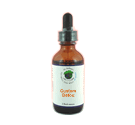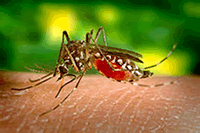|
|
Yellow Fever
The yellow fever virus is transmitted by the bite of female mosquitoes and is found in tropical and subtropical areas in South America and Africa, not in Asia. Since the 17th century, several major epidemics of the disease have been recorded in the Americas, Africa and Europe. In the 19th century, yellow fever was deemed one of the most dangerous infectious diseases.
Yellow fever begins after an incubation period of three to six days. Most cases only cause a mild infection with fever, headache, chills, back pain, loss of appetite, nausea and vomiting. In these cases, the infection lasts only three to four days. However, in fifteen percent of cases sufferers enter a second, toxic phase of the disease with recurring fever. This phase is accompanied by jaundice due to liver damage, as well as abdominal pain, bleeding in the mouth, the eyes and in the gastrointestinal tract that will cause vomitus containing blood (giving the name black vomit). The toxic phase is fatal in approximately 20% of cases, making the overall fatality rate for the disease 3% (15% * 20%).
Surviving the infection causes life-long immunity and normally there is no permanent organ damage.
Due to the increased bleeding tendency (bleeding diathesis), yellow fever belongs to the group of hemorrhagic fevers. The WHO estimates that yellow fever causes 200,000 illnesses and 30,000 deaths every year, with nearly 90% of the infections occurring in Africa. Since the 1980s, the number of cases of yellow fever has been increasing, making it a reemerging disease.
WHO recommends routine vaccinations for people living in endemic areas between the 9th and 12th month after birth. In about 20% of all cases, mild and flu-like symptoms may develop. In rare cases (less than one in 200,000 to 300,000), the vaccination can cause YEL-AVD (yellow fever vaccine-associated viscerotropic disease), which is fatal in 60% of all cases. But in some vaccination campaigns, a 20 fold higher reaction incidence rate has been reported. Age is an important risk factor. In children, the complication rate is less than one case per 10 million vaccinations. Another possible side effect is an infection of the nervous system that occurs in one in 200,000 to 300,000 of all cases. This causes YEL-AND (yellow fever vaccine-associated neurotropic disease), which can lead to meningoencephalitis and in less than 5% of all cases, is fatal.
|
|
| |
Yellow Fever Detox Remedy
Detoxification of all Yellow Fever and related species
$14.95
Read/Write Reviews
|
 Add
To Cart Add
To Cart |
 |
 |
Herpes Detox Remedy
Detoxification of all Herpes and related species
$14.95
|
 Add
To Cart Add
To Cart |
 |
 |
Influenza Detox Remedy
Detoxification of all Influenza and related species
$14.95
|
 Add
To Cart Add
To Cart |
 |
 |
Mumps Detox Remedy
Detoxification of all Mumps and related species
$14.95
|
 Add
To Cart Add
To Cart |
 |
 |
|
|
 Arthropod/Vector
Bacteria
Chemicals
Fungus /Mold
/ Yeast Metals Parasites Virus Other
Arthropod/Vector
Bacteria
Chemicals
Fungus /Mold
/ Yeast Metals Parasites Virus Other


